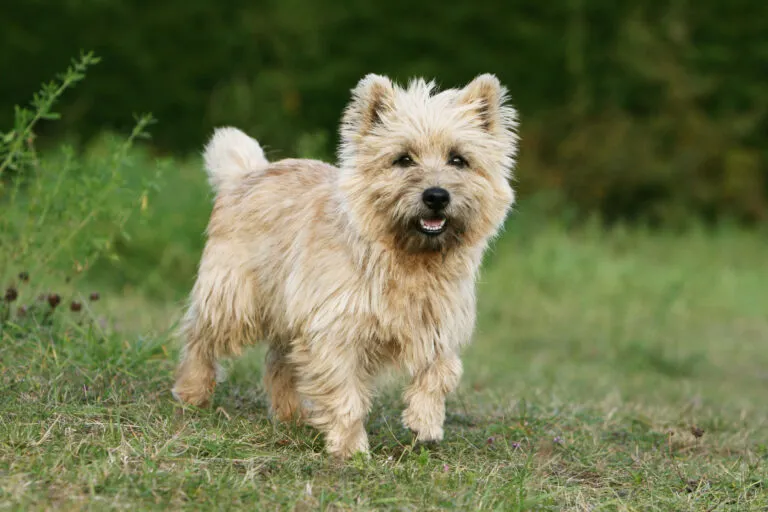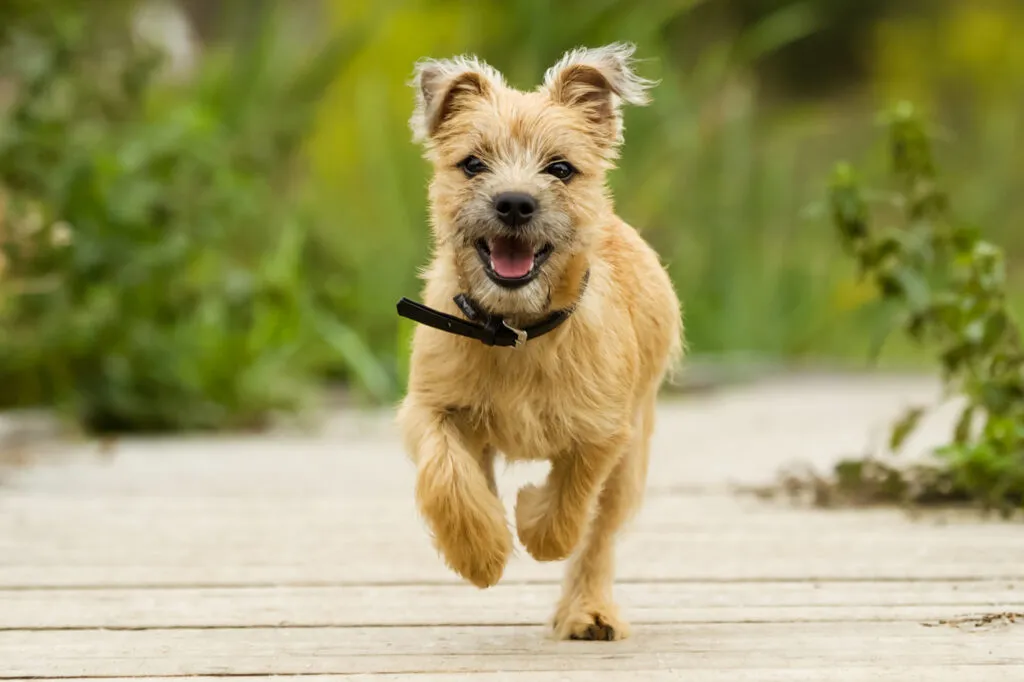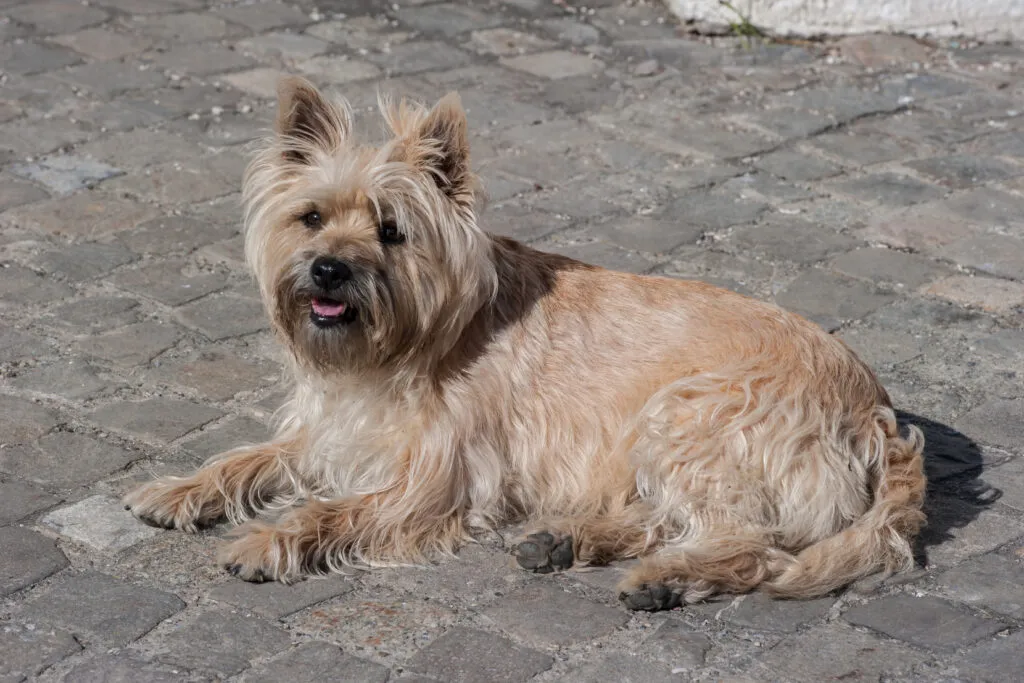Medium Size Poodle
The rugged Cairn Terrier is one of Scotland's oldest hunting terriers, maintaining its rustic appearance, courage, and confidence to this day. While it once chased foxes and badgers under rock piles, this small, friendly adventurer now primarily serves as a companion and family dog.

© Dogs / stock.adobe.com
The Cairn Terrier has a double coat with a harsh outer coat and dense undercoat
Whether it’s a long walk in the forest, wild play on the dog field or concentrated work at the dog sports ground, the lively Cairn Terrier is up for any activity with its family. The main thing is that there is something going on!
As a hunting terrier that tirelessly tracked otters, foxes and badgers in the Scottish moors, the Cairn Terrier has a natural inclination for outdoor activities. It loves to run, search, dig and chase. But don’t worry, the widespread hunting instinct among terriers can be controlled with consistent training, so well-trained and socialised Cairn Terriers can even enjoy running without a lead now and then.
Despite its lively nature and passion for hunting, the Cairn Terrier has become an ideal family dog, bringing much delight to the home with its friendly and patient manner. It loves being with its family and feels comfortable in both single-person households and those with children.
After an obligatory exercise session outdoors, it can also appreciate the tranquility of home. This spirited little adventurer can quickly become an affectionate “lap dog” that thoroughly enjoys spending time close to its owner. It is patient and balanced around children, although it can sometimes act slightly dominant around very young ones.
This breed certainly doesn’t lack in self-confidence. However, despite its dominance and the ability to work independently, the Cairn Terrier is rarely headstrong or stubborn. It is an adaptable companion that easily adjusts to its family’s lifestyle. Stress or nervousness have no place in its balanced and flexible character. Unlike other terrier breeds, the Cairn does not need to engage in brawls. It is always vigilant and ready to defend, but it prefers peaceful and harmonious interactions with other animals and strangers.
The Cairn Terrier’s thick, rough top coat comes in colours like cream, wheaten, red, grey, almost black or brindled – reflecting the colour tones of the Scottish Highlands’ stone landscape that appears reddish, beige or slate-grey. Its ideal weight, 14 English pounds, equals a “stone” (the English measurement). Its strong, thick paws, perfect for digging, also hint at its heritage of hunting among Scottish rock piles.
 © Mikkel Bigandt / stock.adobe.com
© Mikkel Bigandt / stock.adobe.com
The Cairn Terrier retains much of its original look. Compared to its Scottish cousins, the Scottish, Skye and West Highland White Terrier, the Cairn Terrier has most kept its original traits. Its compact, low-set body with a weather-resistant coat of harsh top coat and dense undercoat, strong and muscular legs, and a small, broad head with bushy eyebrows exude great robustness, durability and vitality. Despite a size of just 28 to 31 cm and a weight of only 6 to 7.5 kg, it moves nimbly and powerfully, displaying a very confident and fearless demeanour.
Fitting its primitive appearance, the Cairn Terrier is indeed one of the oldest terriers in Britain. Originating from the Scottish Highlands, it was used long ago as a hunting terrier to track foxes, badgers, martens and other prey among rocks, rock piles and underground. It would dig out its prey, drive them out and even kill them if necessary – a very dangerous and courageous task for such a small dog, especially against well-armed wild animals.
Despite its long and successful history as a working terrier, the Cairn was the last of all terrier breeds to be officially recognised. Before its official registration as a separate breed by the British Kennel Club in 1910, Cairns were classified under other terrier breeds.
Puppies were partially registered as Scottish Terriers, West Highland White Terriers (white-coated puppies) or mostly as a short-haired variant of Skye Terriers. Following protests from Skye breeders, the Cairn Terrier was recognised as a separate breed. In 1910, dogs previously registered as Skye Terriers were the first to be listed as Cairn Terriers in the Kennel Club’s new breed registry.
Despite its separation from other terrier breeds, the Cairn retains a close relationship with the Skye Terrier. Both breeds trace their pure-breeding origins to the Scottish Isle of Skye, near Scotland’s west coast in the Atlantic. Breeder Alastair Campeil is considered the founder of the modern Cairn Terrier. Her dog “Callamhor” was the first registered Cairn Terrier. The first dogs of this breed were shown at a dog exhibition in Scotland in 1909, which likely led to the founding of the Scottish Cairn Terrier Club the same year. A first breed standard was set up in 1912.
Today, the lively, robust dwarf terrier delights dog enthusiasts worldwide. In Europe, besides the UK, breeders can be found in Germany, Austria, the Netherlands, Switzerland as well as Slovenia and Slovakia. The small purebred dog has also made its way across the Atlantic to Canada and the USA, where independent Cairn Terrier clubs now exist.
The range of breeders available to interested individuals is usually quite large. But which breeder is the right one? The answer to this question surely doesn’t depend on who has the cutest puppies. Instead, you will only find the answer after thorough checking and in-person meetings with several breeders. But what should you consider when meeting a breeder?
Buying a purebred, healthy and vaccinated puppy is one of the best prerequisites for a healthy dog life with fewer costly vet visits. Fortunately, due to its preserved original character and appearance, the Cairn Terrier is a relatively healthy small breed, boasting an above-average life expectancy of 15 years.
Health issues mainly involve eye diseases, if any. Cases of glaucoma and entropion are known, the latter commonly referred to as “roll-lid”. For both diseases, early diagnosis significantly improves recovery chances. Entropion can be surgically corrected and rarely reoccurs. For glaucoma, early symptom recognition is crucial as untreated high intraocular pressure can damage the optic nerve and retina, leading to the dog’s blindness in a relatively short time.
 © Eberhard / stock.adobe.com
© Eberhard / stock.adobe.com
Early detection of disease signs hinges on regular care for your dog. By routinely checking its eyes, ears, mouth, paws, and fur, you can identify changes early and report them to your vet. Your Cairn Terrier will likely enjoy a thorough care ritual involving many strokes after a long walk. If you get your dog as a puppy, accustom it early to holding still for occasional deep inspections of its eyes and mouth.
The Cairn Terrier’s coat care care is manageable thanks to its hard and dirt-repellent hair texture. Brushing your dog with a coarse comb or a terrier rake two to three times a week is sufficient. Additionally, trimming the hair two to four times a year helps maintain its texture. Bathing is usually unnecessary and should be done only for very heavy dirt that cannot be removed without water and dog shampoo.
The question of what food should go into your dog’s food bowl often sparks strong opinions. Many first-time dog owners are quickly overwhelmed by the often contradictory advice and the vast array of food options. Having a conversation with your vet or breeder could be illuminating since they have extensive experience with canine nutrition and can consider your dog’s individual needs.
One thing is certain amidst the food confusion: dogs aren’t all the same!
There are young dogs, old dogs, lively dogs, lethargic dogs, allergic dogs or overweight dogs. Keep this in mind when choosing food. To be sure, you can calculate your dog’s nutritional needs by considering individual factors like age, weight, breed, gender, health condition and activity level.
While the specific combination of nutrients may vary based on the criteria mentioned, the basic diet for all dogs is the same. It primarily consists of meat. This means no slaughterhouse waste or animal by-products but pure, high-quality, and preferably fresh meat. Dogs also eat fruits, vegetables, flakes and occasionally an egg. For dental care, you can give beef hide strips, pizzle or bones once a week – but bones should never be hollow as they can easily splinter and cause injuries.
Generally, the robust little Cairn Terrier doesn’t have high demands. However, you should familiarise yourself with the basic rules of dog training and the terrier breed’s specific characteristics before bringing a Cairn into your home – and all family members should be on the same page.
Well-informed and prepared, this terrier breed is sure to become a delightful addition to your household. Whether a cheerful and patient playmate for children, a loyal companion for single individuals or a spirited and engaging sports partner for active people, the adaptable Cairn Terrier fits seamlessly into almost any lifestyle – provided it is well-trained since its hunting instinct and tendency toward dominance need early limitations.
Thanks to its size, it is also comfortable in smaller city apartments – as long as it gets plenty of attention and frequent trips to the park, forest and field for exercise. Initially a hunting and working dog, the Cairn Terrier requires plenty of movement and mental stimulation. It may forgive you for a short walk occasionally, but you should plan a longer outing with your pet the next day. If you have a garden, you can allow the Cairn Terrier outside occasionally – but be aware that this breed loves digging and will enthusiastically root around in the soil. Flowers or simple fences are no obstacles for it.
Fans of the Bearded Collie agree that those who aren't familiar with this dog breed simply have to get acquainted with it. And those who have experienced how a Bearded Collie bolts across meadows with its flowing fur, how it rolls around full of energy and joy and how it attentively and observantly takes into account its owners wishes become simply addicted to this original dog breed and its unique charm.
The Goldendoodle isn't a breed, but a pairing between Golden Retrievers and Medium or Standard Poodles. Marketed as a low-maintenance dog for allergy sufferers, this hybrid is enjoying increasing popularity amongst dog lovers, similar to the Labradoodle.